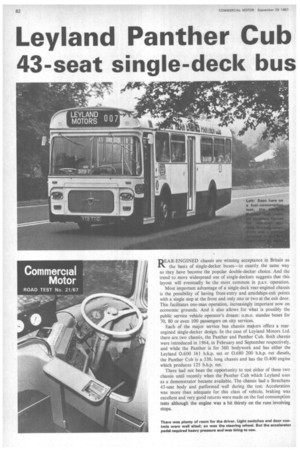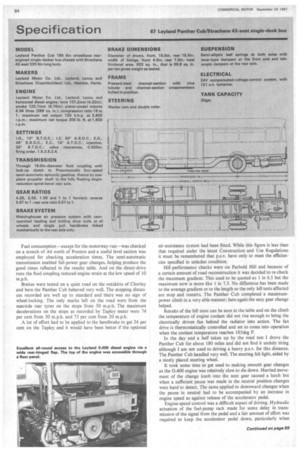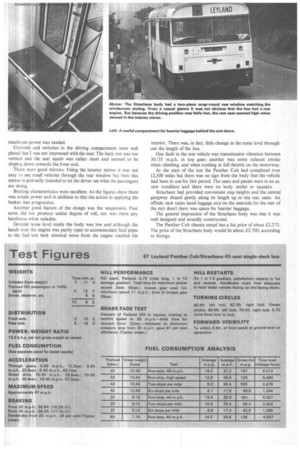Leyland Panther Cub Strachans
Page 84

Page 85

Page 86

Page 91

If you've noticed an error in this article please click here to report it so we can fix it.
43-seat single-deck bus
BY A. J. P. WILDING AMIMechE. MIRTE REAR-ENGINED chassis are winning acceptance in Britain as the basis of single-decker buses—in exactly the same way as they have become the popular double-decker choice. And the trend to more widespread use of single-deckers suggests that this layout will eventually be the most common in p.s.v. operation.
Most important advantage of a single-deck rear-engined chassis is the possibility of having front-entry and amidships-exit points with a single step at the front and only one or two at the exit door. This facilitates one-man operation, increasingly important now on economic grounds. And it also allows for what is possibly the public service vehicle operator's dream: o.m.o. standee buses for 70, 80 or even 100 passengers on city services.
Each of the major service bus chassis makers offers a rearengined single-decker design. In the case of Leyland Motors Ltd. there are two chassis, the Panther and Panther Cub. Both chassis were introduced in 1964, in February and September respectively, and while the Panther is for 3611 bodywork and has either the Leyland 0.600 161 b.h.p, net or 0.680 200 b.h.p, net diesels, the Panther Cub is a 33f1. long chassis and has the 0.400 engine which produces 125 b.h.p. net.
There had not been the opportunity to test either of these two chassis until recently when the Panther Cub which Leyland uses as a demonstrator became available. The chassis had a Strachans 43-seat body and performed well during the test. Acceleration was more than adequate for this class of vehicle, braking was excellent and very good returns were made on the fuel consumption tests although the engine was a bit thirsty on the runs involving stops. The Panther Cub was introduced in the first place following a Manchester Corporation requirement for a chassis shorter than the Panther. Using the 0.400 engine makes for a shorter rear overhang and therefore permits a shorter wheelbase than with the Panther. Wheelbase of the Panther Cub is 16ft 6in and there is a 9ft 3.25 in rear overhang.
Comparable dimensions on the Panther are 18ft 6in and 9ft I lin. There is also a difference in unladen weight. the Panther Cub being about 7ewt lighter. And the Panther is designed for a gross weight of 12 tons as against 10 tons for the Panther Cub.
To some extent the Panther Cub is a special model. Apart from the fact that air suspension and a power-assisted handbrake are options, the chassis is available only in the form as tested.
So that both the entrance and exit can be at a low level, the chassis sidemembers drop down ahead of the rear axle. Straight side-members, gently sloping upwards from front to rear, are employed in coach versions of the Panther and there appears no reason why with suitable packings coach bodies could not be fitted on the shorter chassis. But no doubt few operators would want 33ft-long coaches.
The layout of components on the Panther Cub and the Panther follows the same pattern. Both chassis have the Leyland Pneumocyclic semi-automatic gearbox and this is mounted as a unit with the engine. The drive to the rear axle is through a short propeller shaft, the axle itself having an Eton 1618 single-speed head available in ratios ranging from 4.625 to 7.17 to 1. The Panther is obtainable with an Eton 18802 two-speed axle as well as this unit.
The Panther Cub has the same sized brakes as coach versions of the Panther-15.5in diameter all round, 4.5in wide at the front and 7in at the rear. Both chassis have full air-pressure systems.
For the tests, the Panther Cub was loaded with sandbags to represent its full complement of 43 passengers. The load was removed in two stages for the half-laden and unladen fuel consumption runs. Considering the figures obtained, the model should be reasonably economical to operate although more fuel was used when two stops and six stops per mile were made than is usual with a single-decker.
There has not been the same sort of m.p.g. drop under test with single-decker buses that have had a higher-power engine and it would appear that consumption to be expected on these types of test is largely a function of power-to-weight ratio. With doubledeckers, consumption at six stops per mile normally goes down to about the 6 or 7 m.p.g. returned by the Panther Cub.
Its non-stop consumption figures were very good indeed and it may be that on normal service operation a driver would use less acceleration between stops than I did. To make p.s.v. road tests comparable, COMMERCIAL MOTOR practice is to use virtually maximum acceleration after each stop to reach a running speed of 30 m.p.h. The test stops last 15sec and the engine is left idling— these periods not being taken into account when calculating the average speed.
A high-speed run was completed solely for interest as a service bus will not be used on a motorway service. But the run indicates what can be expected if the model is used as a basis for a coach.
In this case, of course, a higher axle ratio would be fitted to give a higher speed and a better consumption of about 15 m.p.g. could be expected.
It is interesting that consumption did not improve to any great extent when the load was removed and in fact the non-stop runs half-laden and unladen gave the same result. Fuel consumption—except for the motorway run—was checked on a stretch of A6 north of Preston and a useful level section was employed for checking acceleration times. The semi-automatic transmission enabled full-power gear changes, helping produce the good times reflected in the results table. And on the direct-drive runs the fluid coupling reduced engine strain at the low speed of 10 m.p.h.
Brakes were tested on a quiet road on the outskirts of Chorley and here the Panther Cub behaved very well. The stopping distances recorded are well up to standard and there was no sign of wheel-locking. The only marks left on the road were from the nearside rear tyres on the stops from 30 m.p.h. The maximum decelerations on the stops as recorded by Tapley meter were 74 per cent from 30 m.p.h. and 73 per cent from 20 m.p.h.
A lot of effort had to be applied to the handbrake to get 24 per cent on the Tapley and it would have been better if the optional air-assistance system had been fitted. While this figure is less than that required under the latest Construction and Use Regulations it must be remembered that p.s.v. have only to meet the efficiencies specified in unladen condition.
Hill-performance checks were on Parbold Hill and because of a certain amount of road reconstruction it was decided to re-check the maximum gradient. This used to be quoted as 1 in 6.5 but the maximum now is more like 1 in 7.5. No difference has been made to the average gradient or to the length so the only hill tests affected are stop and restarts. The Panther Cub completed a maximumpower climb in a very able manner; here again the easy gear change helped.
Results of the hill tests can be seen in the table and on the climb the temperature of engine coolant did not rise enough to bring the electrically driven fan behind the radiator into action. The fan drive is thermostatically controlled and set to come into operation when the coolant temperature reaches 185deg F.
In the day and a half taken up by the road test I drove the Panther Cub for about 180 miles and did not find it unduly tiring although I am not used to driving a heavy p.s.v. for this distance. The Panther Cub handled very well. The steering felt light, aided by a nicely placed steering wheel.
It took some time to get used to making smooth gear changes as the 0.400 engine was relatively slow to die down. Hurried movement of the change knob into the next gear caused a lurch but when a sufficient pause was made in the neutral position changes were hard to detect. The same applied to downward changes when the pause in neutral had to be accompanied by an increase in engine speed as against release of the accelerator pedal.
Engine-speed control was a difficult aspect of driving. Hydraulic actuation of the fuel-pump rack made for some delay in transmission of the signal from the pedal and a fair amount of effort was required to keep the accelerator pedal down, particularly when maximum power was needed.
Controls and switches in the driving compartment were well placed but I was not impressed with the seat. The back rest was too vertical and the seat squab was rather short and seemed to be sloping down towards the front end.
There were good mirrors. Using the interior mirror it was not easy to see small vehicles through the rear window but then this mirror is primarily intended to let the driver see what the passengers are doing.
Braking characteristics were excellent. As the figures show there was ample power and in addition to this the action in applying the brakes was progressive.
Another good feature of the design was the suspension. Fast turns did not produce undue degree of roll, nor was there any harshness when unladen.
General noise level inside the body was low and although the hatch over the engine was partly open to accommodate feed pipes to the fuel test tank minimal noise from the engine reached the interior. There was, in fact, little change in the noise level throughout the length of the bus.
One fault in the test vehicle was transmission vibration between 30/35 m.p.h. in top gear; another was some exhaust smoke when climbing, and when running at full throttle on the motorway.
At the start of the test the Panther Cub had completed over 12,500 miles b t there was no sign from the body that the vehicle had been in us for this period. The seats and panels were in an asnew condition and there were no body rattles or squeaks.
Strachans h d provided convenient step heights and the central gangway slope gently along its length up to the rear seats. An offside rack tak s hand luggage and on the nearside (to the rear of the exit door) t ere was space for heavier baggage.
The general mpression of the Strachans body was that it was well designed a d soundly constructed.
The Panther ub chassis tested has a list price of about £3,273. The price of th Strachans body would be about £2,700, according to fittings.




































































































































































